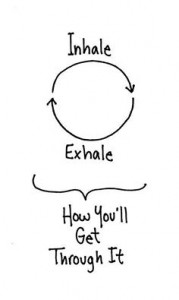
Inhale…exhale… It’s something that we do many times a day without a second thought or any thought. Our respiratory system is one over which we have both voluntary and involuntary control. Thankfully, we do not have to consciously think, “Inhale” to get a breath. Air flows in and out of our bodies even while we sleep or are involved in other activities. The breaths that we take during our waking, routine moments are often on the shallow side, involving only the top third of our lungs. This is enough to minimally satisfy our body’s needs and keep us operating .
Equally, thankfully, we have the ability to interrupt the automatic flow of air in and out of our bodies to take in a long slow inhale, when we think about it. These breaths go deep into the lungs, down to the bottom part where a complex network of blood vessels offers the most efficient exchange of gasses.
Another autonomic system that we have in our bodies is commonly known as the “Fight or Flight Response.” This ancient mechanism of the sympathetic nervous system becomes activated when the brain perceives a threat. When activated, the breath becomes rapid and shallow, blood flow is diverted to the arms and legs, stress hormones are produced in greater quantity, the heart rate and blood pressure both elevate. This puts us in a better position, physiologically, to either fight off the threat or run away from it.
Another part of our nervous system is called the parasympathetic. While the sympathetic nervous system is all about getting our bodies ready for battle or escape, the parasympathetic nervous system is all about chilling. While activated, the body goes into a more restful state. Blood flows more freely to our brains and internal organs. Heart rate and blood pressure drop and our brains begin to produce a pattern of brain waves that is conducive to feeling relaxed.
Back in the day, the threats to our ancient ancestors were more immediate and tangible, think, “Bear walks into camp.” In response, our ancestors either fought or fled (some froze). When the bear was either killed or driven off, everyone’s bodies returned to homeostasis, i.e. blood pressure, heart rates and breathing rates returned to normal and stress hormone production was dialed back.
The threats that we encounter today are much less tangible and often only occurring in our imaginations. Our fast paced, have-it-all-now society encourages feelings of being out of control and inadequacy. These are powerful beliefs that can keep us in a constant state of sympathetic nervous system activation. It’s like keeping the engine in your car revved up all the time, even when stopped at a light.
One way to interrupt sympathetic response and initiate parasympathetic response is to consciously take long, slow, deep breaths. This interrupts the flow of sympathetic nervous system activity and signals the brain that we are safe, that it’s is okay to relax, okay to rest and digest.
Remember to stop throughout the day to check in on how you are feeling. Take in several long, slow, deep breathes. Remind your body and brain that you are safe from immediate harm. Give yourself the opportunity to relax. As the engine of a gently idling car will last much longer than one that is constantly revved, your parasympathetically stimulated body and mind will, also, last much longer. Inhale…exhale…

